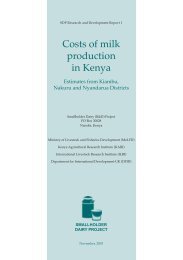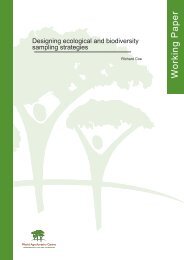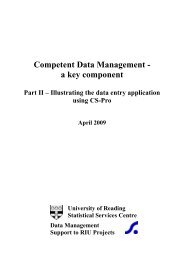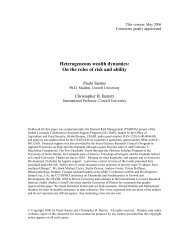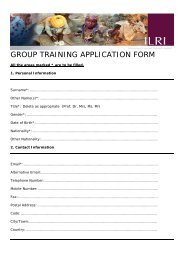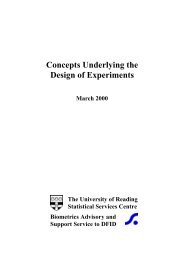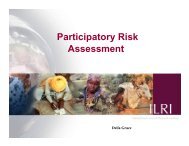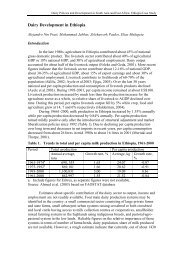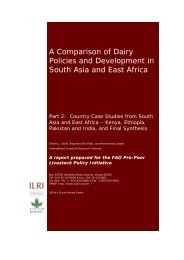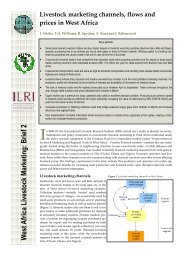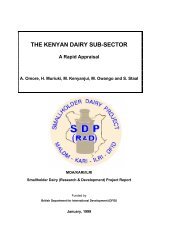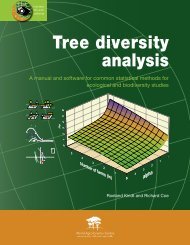Improvement of Livestock Production in Crop-Animal Systems in ...
Improvement of Livestock Production in Crop-Animal Systems in ...
Improvement of Livestock Production in Crop-Animal Systems in ...
Create successful ePaper yourself
Turn your PDF publications into a flip-book with our unique Google optimized e-Paper software.
Project susta<strong>in</strong>abilityStrategies for ensur<strong>in</strong>g the success and susta<strong>in</strong>ability <strong>of</strong> future projects need to be sensitive, <strong>in</strong>ter alia, to thefollow<strong>in</strong>g concerns:1. Project formulation should be based on a response to ex-ante analysis to <strong>in</strong>clude identification <strong>of</strong>constra<strong>in</strong>ts, analysis <strong>of</strong> trends and issues, and def<strong>in</strong>ition <strong>of</strong> research priorities.2. Projects should <strong>in</strong>volve farmers and community-based participation, where beneficiaries have a directstake <strong>in</strong> all aspects <strong>of</strong> the project from formulation through implementation to evaluation. Participation<strong>in</strong> decision-mak<strong>in</strong>g is central to the success <strong>of</strong> any project.3. Projects should be flexible <strong>in</strong> scope and direction, and be responsive to chang<strong>in</strong>g circumstances.4. Project stability is ensured by <strong>in</strong>stitutional commitment, adequate resources, recipient contribution andstrong partnerships.Priority production systemsThe follow<strong>in</strong>g priority production systems are identified for future research:1. Annual food crop systems <strong>in</strong>tegrated with rum<strong>in</strong>ants and/or non-rum<strong>in</strong>ants.2. Perennial tree crop systems <strong>in</strong>tegrated with rum<strong>in</strong>ants.Annual food crop systems are found <strong>in</strong> all countries, but their <strong>in</strong>tegration with animals is particularlyimportant <strong>in</strong> the Mekong countries and South Ch<strong>in</strong>a. Perennial tree crop systems are also found <strong>in</strong> mostcountries, but are most important <strong>in</strong> the ASEAN sub-region.Priority researchable areasPotential research issues may be grouped <strong>in</strong>to six <strong>in</strong>terrelated areas (Table 13). The seventh area relates to<strong>in</strong>stitution build<strong>in</strong>g. With feed resources, considerable work has been undertaken on the development <strong>of</strong>improved forages, but there has been little emphasis on the <strong>in</strong>troduction <strong>of</strong> annual forage legumes <strong>in</strong>to food cropsystems. Only limited work has been conducted on forage utilisation by animals with<strong>in</strong> the production systems,and little attempt has been made to synchronise the available feed options with animal requirements throughoutthe year. Nutrient cycl<strong>in</strong>g provides the l<strong>in</strong>k between the animal on the one hand and the soil and crop on theother. In most smallholder systems, manure is the only <strong>in</strong>put for the ma<strong>in</strong>tenance <strong>of</strong> soil fertility. The production<strong>of</strong> crop residues, AIBP and NCFR need to be <strong>in</strong>tegrated better <strong>in</strong>to farm<strong>in</strong>g systems and utilised more efficiently<strong>in</strong> feed<strong>in</strong>g systems. A major effort is required to promote their wider adoption by farmers.<strong>Animal</strong> genetic resources <strong>in</strong> the region have not been characterised adequately, and traits responsiblefor environmental adaptation need to be utilised <strong>in</strong> a more concerted manner. Genetic resistance to diseases,for example, is an area where more research needs to be undertaken. <strong>Animal</strong> improvement programmes <strong>in</strong>South-East Asia have generally tended to place too much emphasis on crossbreed<strong>in</strong>g, with variable success,ma<strong>in</strong>ly to improve milk and meat production <strong>in</strong> <strong>in</strong>tensive systems. For crop–animal systems, on the otherhand, crossbreed<strong>in</strong>g programmes are less important as small farmers are more concerned with diversify<strong>in</strong>gthe use <strong>of</strong> local resources. Thus, the use <strong>of</strong> native breeds (rum<strong>in</strong>ants and non-rum<strong>in</strong>ants) <strong>in</strong> crop–animalsystems assumes much more importance and, with improved nutrition, productivity can be <strong>in</strong>creased.Epidemiological tools and methodologies, contributed by <strong>in</strong>ternational research, could provideimportant improvements for disease monitor<strong>in</strong>g and control. ILRI has special capacity for research <strong>in</strong> animalhealth and diseases <strong>of</strong> relevance to several countries <strong>in</strong> South-East Asia. These <strong>in</strong>clude disease diagnosis andepidemiology <strong>of</strong> tick-borne diseases and mechanically-transmitted trypanosomiasis <strong>in</strong> Indonesia, the LaoPDR, the Philipp<strong>in</strong>es and Vietnam. Vacc<strong>in</strong>e delivery and diagnostics are relevant <strong>in</strong> all countries, and much<strong>of</strong> the immunology work with Theileria could be applied to viral vector delivery mechanisms for otherdiseases such as malignant cattarrhal fever, <strong>in</strong> collaboration with other groups <strong>in</strong> that field. Helm<strong>in</strong>thiasis andresearch on helim<strong>in</strong>th resistance has relevance to small rum<strong>in</strong>ants <strong>in</strong> Indonesia, Thailand and, perhaps, <strong>in</strong>Myanmar.



